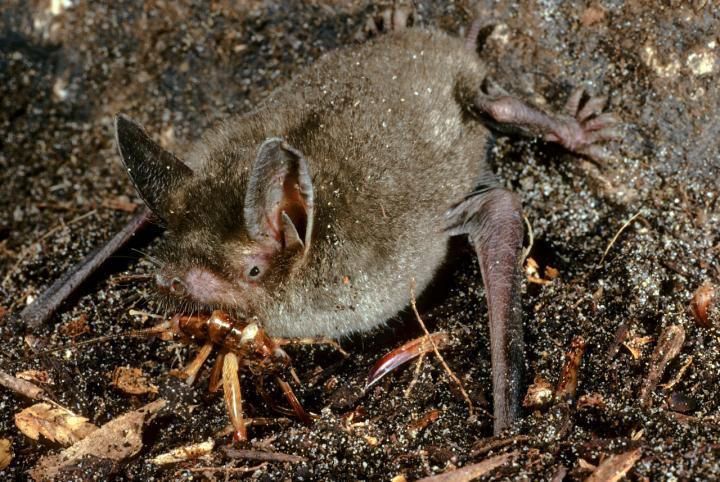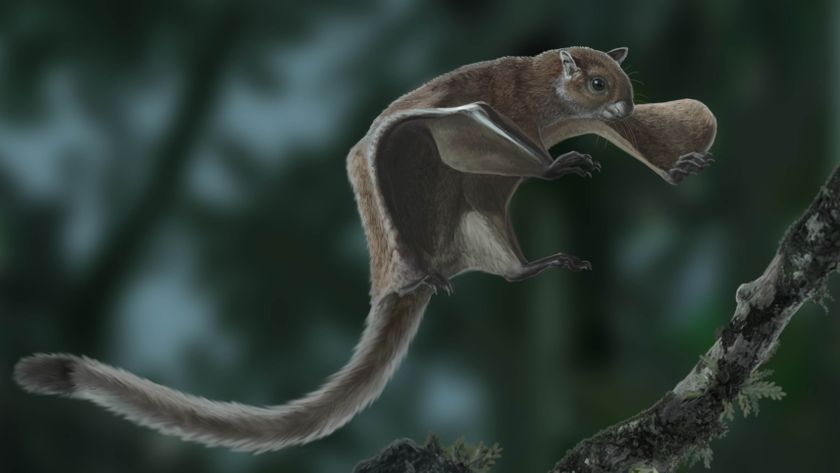Giant 'Walking Bat' Once Prowled Rainforest Floors

About 16 million years ago, a giant bat used all four of its limbs to stalk around the subtropical rainforest of modern-day New Zealand, a new study finds.
The bat, a newly discovered species (Mystacina miocenalis), is large, about three times heavier than a modern bat, the researchers said. It's related to Mystacina tuberculata, a bat that still lives in New Zealand's old-growth forests.
Researchers found the bat fossil in sediment from the site of Lake Manuherikia, a vast prehistoric body of water once located on New Zealand's South Island. The lake is a favorite digging ground for paleontologists, who have found fossilized frogs, lizards, birds, crocodiles and turtles there over the years. A subtropical rainforest surrounded the lake during the early Miocene Epoch, between 19 million and 16 million years ago, when the bat strode around the forest, the researchers said. [Flying Mammals: See Photos of Spooky Bats]
"Our discovery shows for the first time that Mystacina bats have been present in New Zealand for upwards of 16 million years, residing in habitats with very similar [to current] plant life and food sources," lead researcher and vertebrate paleontologist, Suzanne Hand, an associate professor at the University of New South Wales (UNSW) in Australia, said in a statement.
The new fossil shows that New Zealand has a "batty" history. Bats are the country's only native terrestrial mammals. Two of the country's three known native bat species belong to the Mystacina genus, though one of those species hasn't been seen since the 1960s.
These two modern species are burrowing bats that forage in the air as well as on the ground, looking under the leaf litter and snow for food. They scurry about on their wrists and backward-facing feet, keeping their wings furled as they search for edibles, the researchers said.
Scientists had theorized that Mystacina bats had a long evolutionary history in New Zealand. But until now, the oldest South Island Mystacina fossil dated to just 17,500 years ago. The new finding shows that bats are long-term inhabitants of the area, and raises the question of when these odd walking bats first left Australia for modern-day New Zealand, the researchers said.
Sign up for the Live Science daily newsletter now
Get the world’s most fascinating discoveries delivered straight to your inbox.
"Bats are important pollinators and seed dispersers that keep forests healthy," Hand said. "Understanding the connectivity between the bat faunas of different landmasses is important for evaluating biosecurity threats and conservation priorities for fragile island ecosystems."
Country cousins
The fossil shows the ancient bat had surprisingly similar teeth to its modern-day relatives, suggesting ancient and modern bats had similar diets, eating morsels such as nectar, pollen, fruit, insects and spiders. The fossil's limb bones also have structures that, just like its living relative, likely helped it walk around the forest.
But the fossil is much larger than its modern cousin: an estimated 1.4 ounces (40 grams).
"The size of bats is physically constrained by the demands of flight and echolocation, as you need to be small, quick and accurate to chase insects in the dark," Hand said. "The unusually large size of this bat suggests it was doing less in-flight hunting and was taking heavier prey from the ground, and larger fruit than even its living cousin."
The researchers found a diverse array of fossils from plants, animals and insects at the same site, suggesting the 16-million-year-old subtropical forest where the prehistoric bat roamed wasn't so different from the region's present temperate ecosystem.
"Remarkably, the Miocene ecosystems associated with the fossil bat contain the kinds of trees used today by Mystacina for its colonial roosts," Hand said. "Most of its food plants are also represented, as are terrestrial arthropods, including a variety of beetles, ants and spiders, which these bats continue to hunt on the ground."
The findings were detailed online yesterday (June 17) in the journal PLOS ONE.
Follow Laura Geggel on Twitter @LauraGeggel. Follow Live Science @livescience, Facebook & Google+. Original article on Live Science.

Laura is the archaeology and Life's Little Mysteries editor at Live Science. She also reports on general science, including paleontology. Her work has appeared in The New York Times, Scholastic, Popular Science and Spectrum, a site on autism research. She has won multiple awards from the Society of Professional Journalists and the Washington Newspaper Publishers Association for her reporting at a weekly newspaper near Seattle. Laura holds a bachelor's degree in English literature and psychology from Washington University in St. Louis and a master's degree in science writing from NYU.











